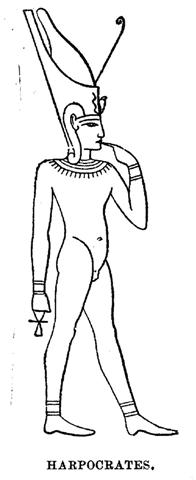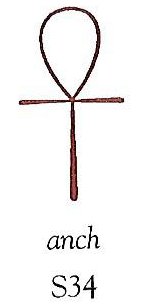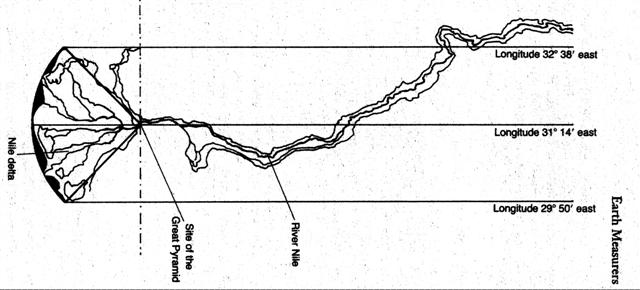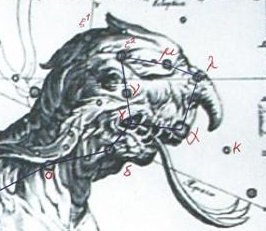497. Possibly the
illustration in Cb9-30
corresponds to the Egyptian ankh knot carried
in the right hand of Harpokrates (Horus) - although
turned upside down:
 
|
o te nuku |
erua nuku |
tagata oho
|
maitaki |
|
Nuku.
1. Pau.: nuka,
crowd, throng.
Ta.: nuú,
army, fleet.
Mg.: nuku,
a host, army. 2.
Mgv.: nuku,
land, country,
place. Sa.:
nu'u,
district,
territory,
island.
Churchill. |
 |
 |
 |
 |
|
Cb9-27 (227 → π) |
Cb9-28 (620 =
392 + 228) |
Cb9-29 |
Cb9-30 (230 → 10
* 23) |
|
CLOSE TO THE SUN: |
|
May
30 (→ 5 * 30 = 150)
no star listed
(70) |
31
TABIT =
π³
Orionis
(71.7),
π²
Orionis (71.9)
320 (South Pole
star, Dramasa) -
71 (Tabit) = 249
(Antares) |
June 1 (152 =
136 + 16)
π4
Orionis (72.1),
ο¹
Orionis (72.4),
π5
Orionis (72.8)
*31.0 = *72.4 -
*41.4 |
2
π¹
Orionis (73.0),
ο²
Orionis (73.4),
HASSALEH =
ι
Aurigae
(73.6),
π6
Orionis (73.9)
*32.0 = *73.4 -
*41.4 |
|
CLOSE TO THE FULL MOON: |
|
Nov 29 (150 +
183)
ATRIA = α Tr.
Austr.
(253.9) |
30 (*254 = *71 + *183)
Tail-6 (Tiger)
WEI (Tail) = ε
Scorpii,
η Arae (254.3),
DENEBAKRAB = μ
Scorpii
(254.7) |
Dec 1 (365 + 335
= 700)
Ophiuchi
(255.3),
GRAFIAS (Claws)
=
ζ
Scorpii
(255.4)
*214.0 = *255.4
- *41.4 |
2 (336 = 320 +
16)
κ Ophiuchi
(256.2), ζ Arae
(256.5), ε Arae
(256.8),
CUJAM (Club) = ε
Herculi
(256.9) |

|
 |
|
hau tea |
Atea changed her sex from
female to male at a certain point in the year:
... When this tremendous task had
been accomplished Atea took a
third husband, Fa'a-hotu,
Make Fruitful. Then occurred a
curious event. Whether Atea
had wearied of bringing forth
offspring we are not told, but
certain it is that Atea and
her husband Fa'a-hotu
exchanged sexes. Then the eyes of
Atea glanced down at those of
his wife Hotu and they begat
Ru. It was this Ru who
explored the whole earth and divided
it into north, south, east, and west
...
 |
up (male) |
|
down (female) |
In ancient Egypt
the Nile delta (Δ)
recieved the
waters from the mountains high
up in the south.

But in ancient
Babylonia the
mountains were high up in the
northeast and the fertile fields
down in the southwest. In ancient
Egypt everything was upside
down.
The rongorongo
idiom has maitaki in
contrast to inoino:
|
 |
 |
|
maitaki |
inoino |
There are 3
ovals and 3 fields, though
maitaki has a
straight line in the middle.
By turning maitaki a
quarter to the right it
becomes rather easy to
identify the line in the middle
with the equator -
similar to the Nile. The
Polynesians had their
ancient homeland
close to the equator and
here the
Sun would have passed straight above
twice in a year - a pair of
midsummers.
But on Easter
Island, south of the
tropical belt, there ought
to
have been a more
recognizable distinction
between the very bad (kinokino)
winter season ('year in
straw') and the good (maitaki)
summer season ('year in
leaf').
|
Maitaki.
Clean, neat,
pure, pretty,
nice, beautiful,
handsome;
tagata rima
maitaki,
clean-handed
man, correct
man. Vanaga. 1.
Good. Henua
maitaki =
the good earth.
2. Shine.
Marama maitaki
= the shining
moon. Barthel.
Ce qui est bon.
Jaussen
according to
Barthel.
Meitaki,
good, agreeable,
efficacious,
excellent,
elegant, pious,
valid,
brilliant,
security, to
please, to
approve (maitaki);
ariga meitaki,
handsome, of
pleasant mien;
mea meitaki
ka rava, to
deserve;
meitaki ke,
marvelous,
better.
Hakameitaki,
to make good, to
amend, to do
good, to bless,
to establish.
Meitakihaga,
goodness. PS
Pau.: maitaki,
good. Mgv.:
meitetaki,
beautiful, good.
Mq.: meitai,
good, agreeable,
fit, wise,
virtuous. Ta.:
maitaiki,
good, well. Niuē:
mitaki,
good.
Maitakia,
clean.
Churchill. |
|
Kino.
1. Bad;
kikino, very
bad, cursed;
kona kino,
dangerous place.
2. blemish (on
body). Kinoga,
badness, evil,
wickedness;
penis.
Kinokino,
badly made,
crude: ahu
kinokino,
badly made ahu,
with coarse,
ill-fitting
stones. Vanaga.
1. Bad, wrong. T
Pau.: kiro,
bad, miserable.
Mgv.: kino,
to sin, to do
evil. Mq.:
ino, bad,
abominable,
indecent. Ta.:
ino,
iino, bad,
evil; kinoga
(kino 1)
sin; Mgv.:
kinoga, sin,
vice. 2. A skin
eruption,
verruga,
blotched skin,
cracked feet T.
Churchill. |
So Hotu
would arrive
only once in a
year, and the
date given in
Manuscript E was
October 15
(288), when the
Explorers
greeted their
king by waving
leaves:
... The canoes of Ava Rei
Pua and of Hotu
were seen near the
(off-shore) islets. On the
fifteenth day of the month
of October (tangaroa
uri) the canoe of
Hotu and the canoe of
Ava Rei Pua landed. On
the fifteenth day of the
month of October (tangaroa
uri), Nonoma
left the house during the
night to urinate outside. At
this point Ira called
out to Nonoma, 'Look
at the canoe!' Nonoma
ran, he quickly went to
Te Hikinga Heru (a
ravine in the side of the
crater Rano Kau) and
looked around. There he saw
the double canoe way out
near the (offshore) islets,
and the two (hulls of the
canoe) were lashed together.
He ran and returned to the
front of the house. He
arrived and called into the
house: 'Hey you! This canoe
has arrived during the night
without our noticing it!'
Ira asked Nonoma,
'Where is the canoe, which
you say is lying out there
(in the water)?' Nonoma's
voice came back: 'It is out
there (in the water) close
to the (offshore) islets!
There it lies, and the two
(hulls) are lashed
together.' The four of them
(corrected for 'the six of
them') went out and picked
up leaves (on branches) to
give signals. They picked
them up, went and arrived at
Te Hikinga and saw
the canoe. Raparenga
got up, picked up the
leaves, took them in his
hands, and waved, waved,
waved, waved ... (E:75)
Probably the
creator of the C text
pointed out this important
point in time by the
eye-catching reversal
between ihe tau in
April 13 compared to April
14 (when the Full Moon =
Hotu reached the
corresponding time on
Easter Island):
|
te hokohuki -
ma te maro |
te hokohuki
ma te maro |
ka ke te manu
ki te maro |
|
Maro.
A
sort of small
banner or
pennant of bird
feathers tied to
a stick.
Maroa: 1. To
stand up, to
stand. 2. Fathom
(measure). See
kumi.
Vanaga.
Maro: 1.
June. 2.
Dish-cloth T P
Mgv.: maro,
a small girdle
or breech clout.
Ta.: maro,
girdle. Maroa:
1. A fathom;
maroa hahaga,
to measure. Mq.:
maó, a
fathom. 2.
Upright, stand
up, get up,
stop, halt. Mq.:
maó, to
get up, to stand
up. Churchill.
Pau.: Maro,
hard, rough,
stubborn. Mgv.:
maro,
hard, obdurate,
tough. Ta.:
mârô,
obstinate,
headstrong. Sa.:
mālō,
strong. Ma.:
maro,
hard, stubborn.
Churchill.
Ta.:
Maro,
dry, desiccated.
Mq.:
mao,
thirst,
desiccated. Fu.:
malo,
dry. Ha.:
malo,
maloo,
id. Churchill.
Mgv.:
Maroro,
the flying fish.
(Ta.:
marara,
id.) Mq.:
maoo,
id. Sa.:
malolo,
id. Ma.:
maroro,
id. Churchill.
MALO ¹,
s. Haw.,
a strip of kapa
or cloth tied
around the loins
of men to hide
the sexual
organs.
Polynesian,
ubique, malo,
maro,
id., ceinture,
girdle-cloth,
breech-cloth.
Sanskr., mal,
mall, to
hold; malla,
a cup;
maltaka, a
leaf to wrap up
something, a
cup;
malâ-mallaka,
a piece of cloth
worn over the
privities ...
Greek,
μηρνομαι;
Dor.,
μαρνομαι, to
draw up, furl,
wind round. No
etymon in
Liddell and
Scott. MALO
², v.
Haw., to dry up,
as water in
pools or rivers,
be dry, as land,
in opposition to
water, to
wither, as
vegetables
drying up;
maloo, id.,
dry barren. Ta.,
maro,
dry, not wet;
marohi, dry,
withered. A
later
application of
this word in a
derivative sense
is probably the
Sam. malo,
to be hard, be
strong;
malosi,
strong; the
Marqu. mao,
firm, solid; N.
Zeal., maroke,
dry; Rarot.,
Mang., maro,
dry and hard, as
land. Sanskr.,
mŗi,
to die;
maru,
a desert, a
mountain;
marut,
the deities of
wind;
marka,
a body;
markara,
a barren woman;
mart-ya,
a mortar, the
earth;
mîra,
ocean.
For the argument
by which A.
Pictet connects
maru
and
mira
with
mŗi,
see 'Orig.
Ind.Eur', i.
110-111. It is
doubtless
correct. But in
that case 'to
die' could
hardly have been
the primary
sense or
conception of
mŗi.
To the early
Aryans the
desert, the
maru,
which approached
their abodes on
the west, must
have presented
itself primarily
under the aspect
of 'dry, arid,
sterile,
barren', a sense
still retained
in the
Polynesian
maro.
Hence the sense
of 'to wither,
to die', is a
secondary one.
Again, those
ancient Aryans
called the deity
of the wind the
Marut;
and if that
word, as it
probably does,
refers itself to
the root or stem
mŗi,
the primary
sense of that
word was
certainly not
'to die', for
the winds are
not necessarily
'killing', but
they are
'drying', and
that is probably
the original
sense of their
name. Lat.,
morior,
mors,
&c. Sax.,
mor,
Eng.,
moor,
equivalent to
the Sanskr.
maru.
(Fornander) |
 |
 |
 |
|
Cb8-9 (392 + 180
= 572) |
Cb8-10 |
Cb8-11 |
| CLOSE TO THE FULL MOON: |
|
Oct 13
ε Centauri
(206.3), κ Oct.
(206.4)
*165.0 = *206.4 - *41.4 |
14
no star listed
(207) |
15 (288)
τ
Bootis (208.2),
BENETNASH
(Leader of the
Daughters of the
Bier) =
η
Ursae Majoris
(208.5),
ν
Centauri
(208.7),
μ
Centauri,
υ
Bootis (208.8) |
|
'Sept 16 |
17 (260) |
18 |
|
CLOSE TO THE
SUN: |
|
April 13
ACHERNAR (End of
the River) =
α
Eridani
(23.3),
χ
Andromedae
(23.6),
τ
Andromedae
(23.9) |
14 (104)
ALSEIPH
(Scimitar) = φ
Persei
(24.5),
τ
Ceti (24.7) |
15 (470)
no star listed
(25) |
|
'March 17 |
18 |
19 (78) |
| 9 |
koia ia |
kua haga ia - kua huki |
koia ra - tona mea |
 |
 |
 |
| Cb8-21 (584 = 392 + 192) |
Cb8-22 |
Cb8-23 (171 + 23 = 194) |
| CLOSE TO THE FULL MOON: |
| Oct 25 (115 + 183)
τ Lupi, δ Oct. (218.1), φ Virginis (218.7)
FOMALHAUT (α Piscis Austrini) |
26 (365 + 299 = 664)
σ Lupi (219.1), ρ Bootis (219.5), HARIS (Keeper) = γ Bootis (219.7 |
27 (300)
σ Bootis (220.2), η Centauri (220.4)
*179.0 = *220.4 - *41.4 |
 |
| ºOct 21 |
22 (295) |
23 |
| 'Sept 28 |
29 |
30 (273) |
| "Sept 14 |
15 |
16 (259) |
| AUG 21 |
22 (600) |
23 (236) |
| CLOSE TO THE SUN: |
| April 25 (115 = 480)
ξ¹ Arietis (35.0), ρ Ceti (35.4), ξ² Ceti (35.9) *359.0 = *35.4 - *41.4 |
26
σ Ceti (36.9) |
27
ν Ceti (37.9) |
 |
| ºApril 21 (111) |
22 |
23 |
| 'March 29 (88 = 115 - 27) |
30 |
31 |
| "March 15 (74 = 115 - 41) |
16 |
17 |
| FEBR 20 (51 = 115 - 64) |
21 |
22 |
Although
the Sun King reached Easter
Island only once in a
year there were two
sides on a rongorongo
tablet and therefore we
can find the arrival of
Hotu also towards
the end of side a. And
likewise were the 5
remaining of the Explorers
leaving also early on side b:
 |
 |
 |
 |
 |
 |
|
*Ca14-24 |
*Ca14-25 |
*Ca14-26 |
*Ca14-27
(390) |
*Ca14-28 |
*Ca14-29 |
|
April 11
(101)
δ
Phoenicis
(21.5) |
12
PINWHEEL
GALAXY
(M33
Trianguli
(22.1),
υ
Andromedae
(22.9) |
13
ACHERNAR
(End of
the
River) =
α
Eridani
(23.3),
χ
Andromedae
(23.6),
τ
Andromedae
(23.9) |
14 (104)
ALSEIPH
(Scimitar)
= φ
Persei
(24.5),
τ
Ceti
(24.7)
|
15 (470)
no star
listed
(25)
|
16 (1½ *
314)
ANA-NIA-10
(Pillar-to-fish
by)
χ
Ceti
(26.1),
POLARIS
=
α
Ursae
Minoris,
BATEN
KAITOS
(Belly
of the
Fish) =
ζ
Ceti
(26.6),
METALLAH
(Triangle)
= α
Trianguli
(26.9) |
|
Oct 11 |
12 |
13 |
14 |
15 (288) |
16 |
 |
 |
 |
 |
 |
|
Cb1-1
(393) |
Cb1-2 |
Cb1-3 |
Cb1-4
(396) |
Cb1-5 |
|
April 17
(107 =
80 + 27)
Al
Sharatain-1
/
Ashvini-1
/
Bond-16
(Dog) /
Mahrū-sha-rishu-ku-1
(Front
of the
Head of
Ku)
SEGIN =
ε
Cassiopeia,
MESARTHIM
=
γ
Arietis,
ψ
Phoenicis
(27.2),
SHERATAN
(Pair of
Signs) =
β
Arietis,
φ
Phoenicis
(27.4)
*351.0 =
*27.4 -
*41.4 |
18
ι
Arietis
(28.0),
λ
Arietis
(28.2),
υ Ceti
(28.8) |
19
ALRISHA
(The
Knot) =
α
Piscium,
χ
Phoenicis
(29.2),
ε
Trianguli
(29.4),
ALAMAK
(Caracal)
=
γ
Andromedae
(29.7)
*353.0 =
*29.4 -
*41.4 |
20
Arku-sha-rishu-ku-2
(Back of
the Head
of Ku)
2h
(30.4)
κ
Arietis
(30.3),
HAMAL
(Sheep)
=
α
Arietis
(30.5)
ALKES (α
Crateris)
|
21
DELTOTUM
= β
Trianguli
(31.2),
ι
Trianguli
(31.7),
η
Arietis
(31.9)
*355.0
|
|
Oct 17
(10 *
29) |
18 |
19 |
20 |
21 |
 |
| Cb1-6 (398) |
| April 22 ξ¹ Ceti (32.1) |
| Oct 22 (295) |
| (231 = 295 - 64) |
 |
 |
 |
| Cb1-7 |
Cb1-8 (400) |
Cb1-9 |
| CLOSE TO THE FULL MOON: |
| April 23 γ, δ Trianguli (33.0), χ Persei (33.2), 10 Trianguli (33.5), θ Arietis (33.3), MIRA (Next to the Pleiades) = ο Ceti (33.7) |
24 (50 + 64) no star listed (34) |
25 (115) ξ Arietis (35.0), ρ Ceti (35.4), 12 Trianguli (35.8), ξ² Ceti (35.9)
*360.0 = *35.4 - *41.4 |
| FEBR 18 (49) |
19 (*336 = *153 + *183) |
20 |
| CLOSE TO THE SUN: |
| Oct 23 (*216 = *152 + *64) |
24 |
25 (298 = 115 + 183) *177 = 6 * 29½ = 172 + 5 |
| AUG 20 (*152 = 232 - 80) |
21 (233 = *153) |
22 (298 - 64 = 234) |
... [E:17] On the
twenty-fifth day of the
first month (Vaitu Nui),
Ira and Makoi
set sail; on the first day
of June ('Maro'), the
bow of Ira's canoe
appeared on the distant
horizon, came closer and
closer on its course, and
sailed along, and finally
(one) could see the (new
home) land
...
...
Ira, Raparenga, Uure, Nonoma,
and Ringiringi got up and left the 'Dark
abyss of Hau Maka' (i.e., Rano Kau),
arrived at Hanga Te Pau, put
the canoe into the water, and sailed off to Hiva,
to Maori. Ira left on the
twenty-fifth day of the month of October (Tangaroa
Uri). When Ira's canoe reached the
islets (off the southwestern coast), Makoi
(who was staying behind) shouted the following
(after him): Eight lands (are there), one has been
found (or, an eighth land has been found for the
first time, evaru kainga katahi i revaa),
that is, Te Pito O Te Kainga. During the fast
journey, one cannot find the seven lands in the
midst of dim twilight. Once (Easter Island) has been
lost, not even eight groups of people (i.e.,
countless boat crews) can find (it) again. - Ruhi
to the right, Pu to the left, necklace around
the neck of Hinariru at Papa O Rae!
[E:86]
According to the
time-frame of Bharani
they left Easter Island
when the Full Moon was
in right ascension day
*360.0, viz. at ρ
Ceti and 5 days after
the Back of the Head
of Ku.

|
Sumerian
SAG |
 |
Phoenician
resh |
 |
Greek
rho |
Ρ (ρ) |
|
...
Resh
(Arabic:
rāۥ)
is the
twentieth
letter
of many
Semitic
alphabets,
including
Phoenician,
Aramaic,
Hebrew
... The
word
resh
is
usually
assumed
to have
come
from a
pictogram
of a
head,
ultimately
reflecting
Proto-Semitic
*raۥ(i)š-.
The
word's
East
Semitic
cognate,
rēš-,
was one
possible
phonetic
reading
of the
Sumerian
cuneiform
sign for
'head'
(SAG).

.jpg)
... Then
I become
aware of
... a
presence
- a
faint,
ghostly
glimmering,
like
moonglow,
that has
appeared
on the
solstice
stone. I
don't
know how
long it
lasts, a
second
or two
only I
would
guess,
but
while it
is there
it seems
less
like a
projection
- which
I know
it to be
- than
something
immanent
within
the
stone
itself.
And it
seems to
function
as a
herald
for it
fades
almost
as soon
as it
has
appeared
and in
its
place
the full
effect
snaps on
-
instantaneously.
It
wasn't
there,
and then
it's
there.
As Chris
had
described,
the
effect
does
curiously
resemble
a
poleaxe,
or a
flag on
a pole,
and
consists
of a
'shaft',
narrow
at the
base but
widening
a little
towards
the top,
running
up the
left
hand
side of
the
solstice
stone,
surmounted
by a
right-facing
'head'
or
'flag'.
An
instant
later an
almond-shaped
spot of
light,
like an
eye,
appears
a few
centimeters
to the
right of
the
'flag'
and the
effect
is
complete.
Weirdly
- I do
not
claim it
has any
significance
- this
flag-on-a-pole
symbol
is the
ancient
Egyptian
hieroglyph
neter,
meaning
'god',
or 'a
god' -
and not
to be
understood
at all
in the
Judaeo-Christian
usage of
that
word but
rather
as a
reference
to one
of the
supernatural
powers
or
principles
that
guide
and
balance
the
universe.
Manifested
here, in
this
strange
Stone
Age
temple,
it
glows,
as
though
lit by
inner
fire
...

Marija
Gimbutas:
'To
sleep
within
the
Goddess's
womb was
to die
and to
come to
life
anew'.
In a
system
of
reincarnation
the old
one must
die in
order to
be
reborn,
of
course.
At
midsummer
Sun
comes to
a
standstill,
and this
must
therefore
be an
occasion
when the
'flame
of life'
had to
be
transported
into a
new
body. |
|























.jpg)
